Enterprise 4.8 Installation
Comprehensive Installation Guide: Meeting Requirements, Preparing the Environment, Step-by-Step Installation, and Notes.
Sections Available in Enterprise Installation
| Function | Description |
|---|---|
| Installation Requirements | Discover the specific hardware, software, and system prerequisites needed for a successful Enterprise V4.8 installation |
| Pre-Installation | Prepare your device step-by-step instructions, including tasks such as system configuration, database setup, and user account management. |
| Installation Instructions | Follow the detailed installation steps provided in the guide to install Enterprise V4.8 on Innoslate, ensuring a smooth deployment of the software. |
| Configuration Notes | Gain insights and recommendations for post-installation configuration tasks, including system tuning to tailor to Enterprise V4.8. |
Installation Requirements
Minimum Requirements:
- Windows 7/8/10/Server 2008/Server 2012/Server 2016/Server 2019
- Dual Core Processor
- 4GB RAM
- 10GB Free Hard Drive Space, a Solid State Drive is recommended (500MB is required for Innoslate Server Files)
- A Microsoft SQL Server 2008 or higher database. SQL Server Express is supported for single computer installations. Please note: if using SQL Server, Full Text Search needs to be installed in order for Innoslate to be installed correctly.
- Alternatively, PostgreSQL databases are also supported.
Recommended Requirements:
- Windows 7/8/10/Server 2008/Server 2012/Server 2016/Server 2019
- Quad Core Processor
- 8GB RAM
- 25GB Free Hard Drive Space, a Solid State Drive is recommended (500MB is required for Innoslate Server Files)
- A Microsoft SQL Server 2008 or higher database. SQL Server Express is supported for single computer installations.
- Alternatively, PostgreSQL databases are also supported.
Pre-Installation
- Install database software that will be used to connect to Innoslate. Innoslate supports SQL Server 2008 (or newer) and PostgreSQL. Express with Advanced Services (SQLEXPRADV) is required to support Full Text Search.
- Please note that if using SQL Server, Full Text Search must be installed.
- Also note that if using SQL Server, you must create the database within SQL.
- Check minimum installation requirements.
- Please note that Usernames and Passwords for any accounts in your database software or Innoslate cannot contain the following special characters:
a. # b. %
c. ^ d. &
e. + f. "
g. ' h. \
i. { j. }
k. | l. !
Installation Instructions
- Use this installation link:
https://innoslate-install.s3.amazonaws.com/Innoslate_4.8.1.1-setup.exe - A windows prompt will come up from the Windows User Account Control, stating that The Microsoft Defender has recognized an app that's unverified. Proceed by clicking "Run Anyway".
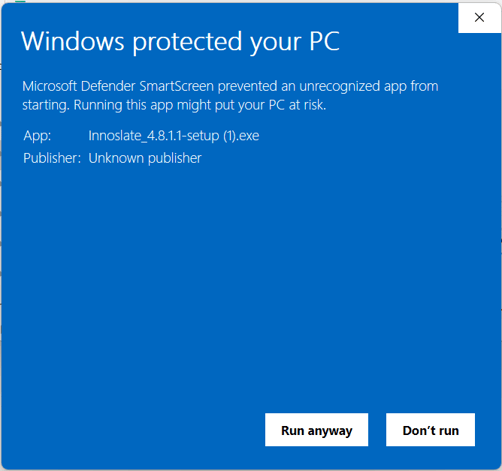
- A prompt will come up to you to communicate that Innoslate makes changes to your computer. Click “Yes” to continue.

- The Innoslate Setup Wizard will open. Click “Next” to continue:

- The wizard should prompt you to agree to the license agreement. Click “I Agree” to continue.
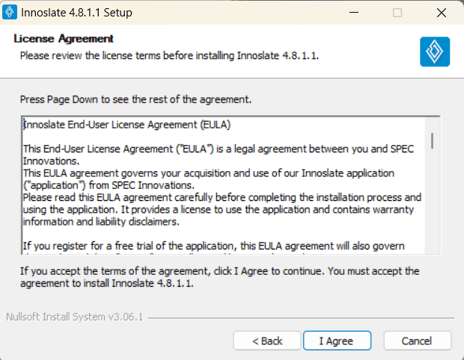
- Select Innoslate4 and Service components to install. Click ‘Next’ to continue.
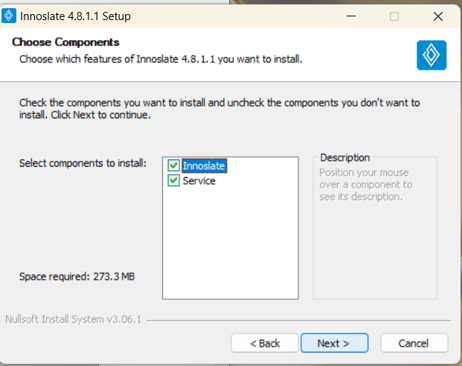
- Keep “C:\Innoslate4” as the destination folder, and click “Next” to continue.
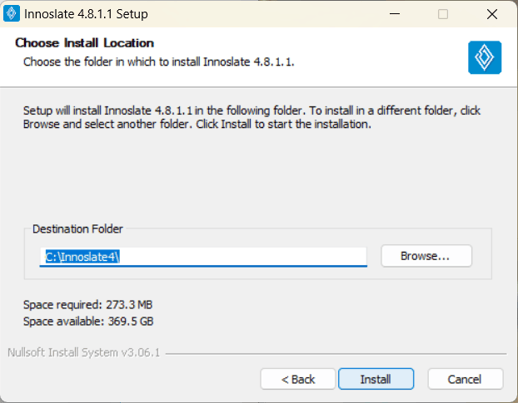
- Once the .exe file is installed, click “Finish.”
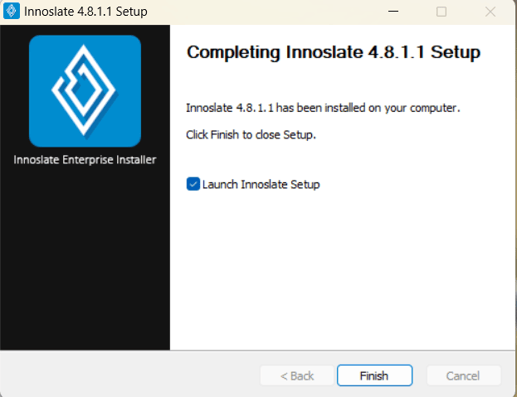
- Your default browser should launch to begin the Innoslate Setup Panel. Accept the Innoslate End-User License Agreement and click ‘Next:
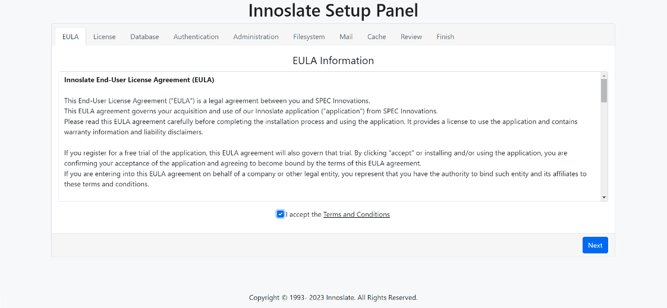
- Drop your license key file or click to upload the license key file and click on ‘Validate’.

- Check to make sure the correct licenses and expiration date pop up. Click ‘Next’ to continue.
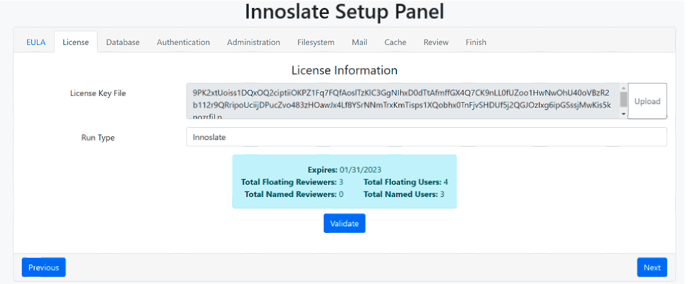
- In PostgreSQL, you do not have to create a database to connect Innoslate to it. You simply need to create the Master Password when you login via pgAdmin 4, after installing PostgreSQL.
- Fill out the fields to access your PostgreSQL database per your configuration. The below picture is an example with PostgreSQL installed on the same computer Innoslate is installed on (localhost).
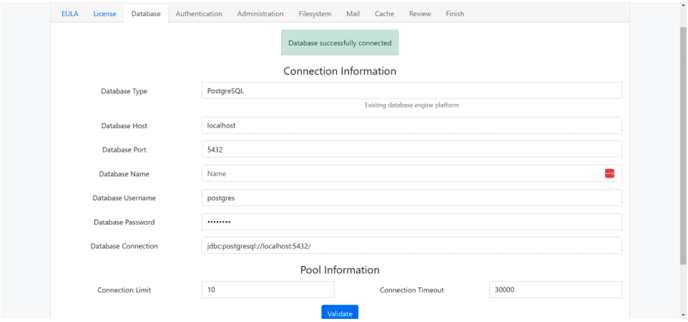
- If the Database software is located on a different computer, you can enter that computer’s IP address in this field.
- PostgreSQL’s default port is 5432. If you changed it, please reflect the proper port to your configuration.
- The database connection string will populate as you fill in the fields above it.
- Pool information is regarding the JDBC Pool. The default is recommended.
12. Once validated you will get the “Database Successfully Connected” popup. Click ‘Next’ to the Authentication Step.
13. If you’d like to setup any other Authentication Type outside of Native, please contact Support for that corresponding documentation.
Note: You can always go back and configure your authentication type after install.

14. Click Next to set up your "Super Admin" Innoslate System Administrator account to become a "Super Admin". Once you get the green checkmarks, you are ready to click on the ‘Next’ button:
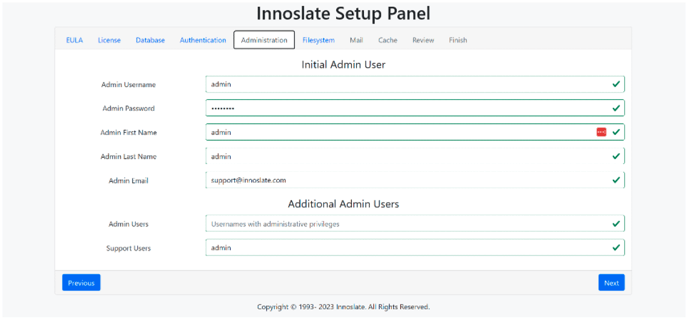
- As shown above, this step will create your Innoslate System Administrator account who will have access to everything in the software to manage and configure your entire Innoslate instance, organization, users and projects. Essentially, this account will have access to everything.
- Users under the Additional Admin User section can be placeholders, or they can be added after installation is setup.
- Support Users are for users you’d like to have access to the Support Dashboard to assist other users with activation links and password resets. These can also be setup after installation.
15. This step is to configure your Filesystem:

- The file system page is for configuring your output reports from Innoslate, the file size limit when uploading a file into Innoslate and to configure the location of the uploaded file.
- We suggest the default for the File Information, for 100MB max file upload and 10,000,000 max entities in a report.
- Filesystem information is where uploaded files into Innoslate will be located on the computer. You can put it on the native computer or on AWS Simple Service Storage (S3), you can select where on your Amazon Simple Storage Service you’d like to save these files. For the S3 setup, please contact Support for additional assistance if needed.
16. Click ‘Next’ to configure email notifications:

- You can set up with no email notifications and go back to set this up after installation.
17. Click ‘Next’ to set up your Browser’s Cache options:

- Native cache option is to use Innoslate’s Tomcat
- Redis Cache option is for users using the Redis software as their cache management system. For more details on this, please contact Innoslate Support.
18. Once your Cache Type is selected, click ‘next’ for the Review Step. This step reflects what your settings.properties file, the configuration file used within Innoslate, will look like. It should reflect everything you’ve set up in the previous steps:
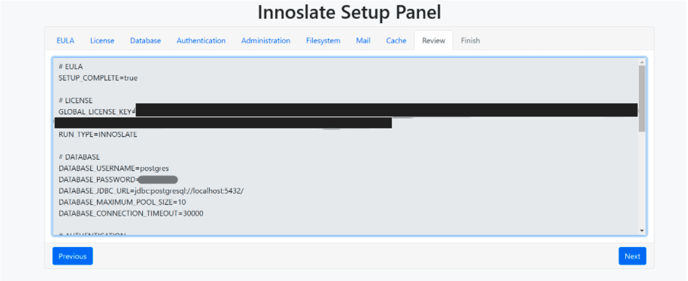
19. Once you’ve reviewed and approved this step, click ‘Next’ to Finish the installer.
20. The Finish Step requires applying the settings you’ve configured. At this step, click ‘Apply Settings’:

21. Innoslate will confirm you’ve installed Innoslate successfully:

22. Once you click Finish, it will direct you to the sign in page:
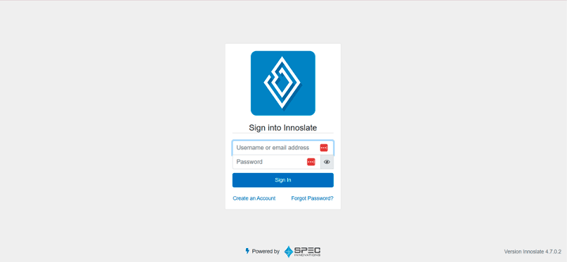
23. Login with the Admin credentials you created in the Administration step of the Setup Panel.
24. You will then be directed to the Admin Dashboard where you can now create your organizational sandbox.
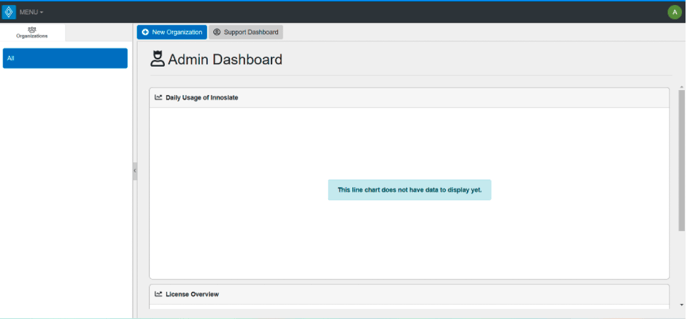
25. Click on the +New Organization blue button to create your organizational sandbox. A pop up will show up to give it a name, slug description and entity limit (TIP: zero (0) is unlimited).
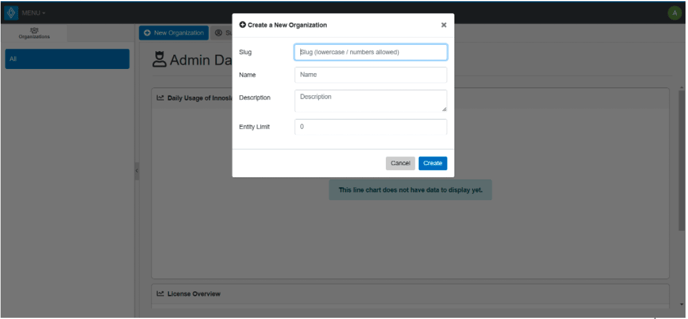
26. You will then be directed to your organization’s Admin Dashboard. The middle bottom panel is the license panel. Hover your mouse over the top right and a pencil will appear. Click on the pencil to make edits and apply licenses to the organization as applicable.
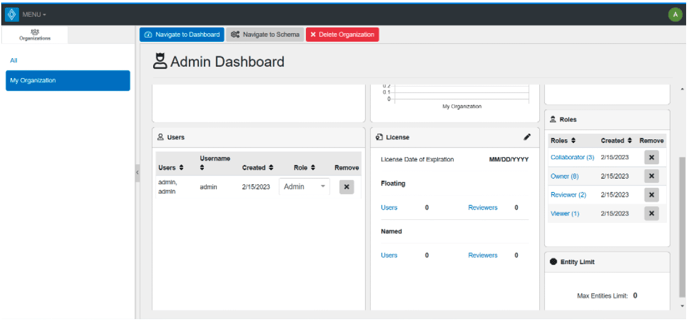
Configuration Notes
General
- The forms above are filled with sample data. Your form should be filled in with your appropriate settings and data. If you are using a SQL database, leave “Microsoft SQL Server” selected. The “Username” and “Password” fields are for the database administrator credentials.
- If you will be running Innoslate locally on your machine, the Database Host will be “localhost”. If you are accessing Innoslate on a local server, talk to your system administrator for instructions. After all the fields are filled out, click on “Test Connection” to make sure everything is set up properly. If the database connection is confirmed, click “Next” to continue.
- If you would like to set up a default organization that all users will be automatically added to, you will need to navigate to your “settings.properties” file (located at Innoslate4\apache-tomcat-8.5.30\webapps\innoslate4\WEB-INF) , and add a field called “DEFAULT_ORGANIZATION_NAME” and another field called “DEFAULT_ORGANIZATION_SLUG”, and create a name for both. Please note that the slug has to be in all lowercase characters. After that, you will need to create the organization from the administrator panel, and make sure it has the same name and slug as in the “settings.properties” file.
Note: If you have sign-in failure issues, check a few things:
-
- Are you using the correct username and password?
- Is the Innoslate4 service running on your computer?
- Is your database configured correctly?
Note: Any changes to Innoslate files will require a full restart of the Innoslate service to apply
Configuration Mail Notifications
In order to configure mail notifications within your local installation, you will need to navigate to your “settings.properties” file, found within the Innoslate4 folder at the following directory: “Innoslate4\apache-tomcat-8.5.30\webapps\innoslate4\WEB-INF”. Next you will need to add the following fields:
- IMPORTANT_MAIL_FROM = <email@address.com>
- IMPORTANT_MAIL_FROM_FROMNAME = Innoslate
- MAIL_SMTP_USERNAME = <YourSmtpUsername>
- MAIL_SMTP_PASSWORD = <YourSmtpPassword>
- MAIL_HOST = <SMTP mail host address> (Example: email-smtp.us-east-1.amazonaws.com)
- MAIL_PORT = <mail port number> (Example: 587)
- MAIL_FROM = <email@address.com>
- MAIL_FROMNAME = Innoslate Notification
The above settings need to be configured to point to an email server you control to have Innoslate automatically send emails out. If all these settings are configured properly, Innoslate will read these settings and send emails through your email system.
Note: after applying these setting, do a service restart in the window services or use the restart_innoslate_service.cmd which can be found in the utilities folder. Otherwise these settings changes will not take effect.
Configuration Default Organization
In order to configure a default organization within your local installation, you will need to navigate to your “settings” properties file, found within the Innoslate4 folder at the following directory: “Innoslate4\apache-tomcat-8.5.30\webapps\innoslate4\WEB-INF”. Next you will need to add the following fields:
- DEFAULT_ORGANIZATION_NAME = <Default Organization Name> (e.g. “My Organization”)
- DEFAULT_ORGANIZATION_SLUG = <Organization Slug> (e.g. “myorganization”)
This will set up a default organization to which every new user will be automatically added.
The default organization slug must be in all lowercase lettering and must not contain any spaces or special characters.
Note: after applying these setting, do a service restart in the window services or use the restart_innoslate_service.cmd which can be found in the utilities folder. Otherwise these settings changes will not take effect.
Configuring the URL Address
You have the option to customize the URL of Innoslate to match your specific environment. This feature is especially beneficial when users need to reset their password because the link generated from the Support Dashboard will be tailored to your specific environment. To configure this add the following field to your “settings” properties file, found within the Innoslate4 folder at the following directory: “Innoslate4\apache-tomcat-8.5.30\webapps\innoslate4\WEB-INF."
- SERVER_ADDRESS = https://myorganizationurl.innoslate.com
Configuring Timeout Settings
To specify your session timeout settings, you will need to navigate to your “web.xml” file, found within the Innoslate4 folder at the following directory: “Innoslate4\apache-tomcat-8.5.30\webapps\innoslate4\WEB-INF”. You will need to open it up and modify the following field:
- <session-config>
- <session-timeout>30</session-timeout>
- </session-config>
You will need to modify “30” to the number of minutes you want the session to stay active.
Note: after applying these setting, do a service restart in the window services or use the restart_innoslate_service.cmd which can be found in the utilities folder. Otherwise these settings changes will not take effect.
Configuring Report Limit
If you would like to set a specific limit to the number of entities within the reports you download, you can specify that by navigating to the “settings.properties” file, found within the Innoslate4 folder at the following directory: “Innoslate4\apache-tomcat-8.5.30\webapps\innoslate4\WEB-INF”. You will need to open it up and add the following field:
REPORT_LIMIT = number of entities
Note: after applying these setting, do a service restart in the window services or use the restart_innoslate_service.cmd which can be found in the utilities folder. Otherwise these settings changes will not take effect.
Configuring Innoslate Port
To change the 8080 port Innoslate is running on, you'll need to access the following XML file in the Innoslate files: C:\Innoslate4\apache-tomcat\conf\server.xml and update the following to change to the port to what you want.
<Connector port="8080" protocol="HTTP/1.1"
connectionTimeout="20000"
redirectPort="8443" />
Note: after applying these setting, do a service restart in the window services or use the restart_innoslate_service.cmd which can be found in the utilities folder. Otherwise these settings changes will not take effect.
Open AI Configuration (added in Innoslate 4.8)
Innoslate 4.8 added AI Chat capabilities power by OPEN AI's ChatGPT. This can be turned on by adding the following to the settings.properties file:
OPEN_AI_API_KEY = <API KEY> This will be provided by ChatGPT.
OPEN_AI_ORGANIZATION = <ORG KEY> If using an organization with your OPEN AI account, your organization name will be entered here.
New field in settings.properties to turn off OPENAI by organization (Added in 4.9): CHAT_AI_EXCLUDED_SLUGS = takes a comma-separated list of organization slugs:
EX: CHAT_AI_EXCLUDED_SLUGS = test, demo
Please note, your account must be a paid customer on the OPEN AI end in order for the chat to work.Troubleshooting
- Innoslate Service did not install correctly and is missing: Attempt to refresh the list of services, and if Innoslate4 does not show up on the list, then navigate to your C:// drive, and locate the folder called “Innoslate4.” Click on the folder and then navigate to the “utilities” folder. In that folder there should be a utility called “install_innoslate_service.” Click on that, and the Innoslate service will be installed. Then, run the “restart_innoslate_service” batch file to start up the service.
- Unable to connect to database:
- Check the connection to your database server (whether it be SQL server, or PostgreSQL) and verify that the service is running and that the database is created.
- Check that the database admin credentials are correct, then check to make sure the username and password for the database admin credentials don’t contain special characters (e.g. # % ^ & + “ ‘ \ { } \).
- Check if the database name is correct. If all of the above settings are correct, check with your systems administrator for troubleshooting help.
- If you are using SQLServer or SQLExpress, check to make sure Full Text Search is enabled. You can determine if Full-Text Search is installed and enabled by querying the FULLTEXTSERVICEPROPERTY. Use this Query:
-
- “SELECT FULLTEXTSERVICEPROPERTY('IsFullTextInstalled')”.
- If the query returns 1, then Full-Text Search is enabled. If it returns 0, then Full-Text Search is not enabled and you will need to run SQL Server Installation Center to add the Full-Text Search feature.
-
- Java version issues: Locate the “Utilities” folder and click on “set_java_home_path.” This batch file will attempt to locate your java home path, and if java is not installed, it will install it automatically.
- Browser setup was interrupted: if you accidentally closed the browser before setup was complete or if your internet connection failed and you need to start the process over again, navigate to the “utilities” folder, and click on “launch_localhost_setup.” This batch file will bring up your browser and start the setup process for you.
- Innoslate hangs/won’t start: First, make sure your Innoslate service is running. If you are unsure, navigate to the “utilities” folder and click on".
To continue learning about Enterprise User Guides, Click Here.
(Next Article: Innoslate's API)
